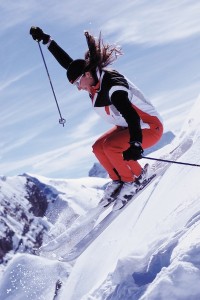Ski and snowboard season is in full swing and that means so are snow-related injuries! A basic understanding of the common injuries related to winter sports not only helps prevent such injuries, but also can allow you to positively identify an injury earlier, minimizing the potential for longer-term effects and/or disability arising from ski- or snow-related accidents.
Skier’s Thumb
Often called gamekeeper’s thumb, this injury occurs when a ski pole is held between the thumb and index finger during grasp – causing a severe stretching injury to the thumb during even a routine fall. Essentially, it’s a thumb sprain that stretches or tears the ulnar collateral ligament of the thumb.
A simple exam by a trained physician can diagnose skier’s thumb, but it is important to obtain an x-ray to rule out fracture; occasionally, an MRI is required to confirm diagnosis.
Treatment for skier’s thumb depends on both the instability of the thumb as well as the severity of the tear. Once properly diagnosed, most sprains deserve an attempt at full-time splinting to allow proper healing. However, certain complete ligament tears that become displaced, called Stener lesions, will not heal without surgical reattachment and are best addressed early. Additionally, many complete tears do not heal fully, which can lead to chronic pain and instability of the thumb; these serious cases require repair or reconstruction.
Prevention of this injury includes holding ski poles outside the thumb and avoiding use of ski pole straps.
Wrist Fracture
While there are many bones that can be broken in the wrist, the most common wrist injury is fracture of the end of the radius bone at the wrist. This injury accounts for a quarter of all snowboarding injuries and often requires casting or even surgery, depending on the severity of the break.
It is important to distinguish a wrist sprain from a wrist fracture. Persistent, painful swelling and the inability to bear weight on the wrist are signs to seek a professional evaluation and x-ray to rule out fracture.
Learning to break falls with the knees and forearms, rather than outstretched hands, can help skiers and snowboarders prevent wrist fractures.
Shoulder Dislocation
Shoulder dislocation is a common injury that occurs most often from a fall on an outstretched hand or a twisting impact injury. Often associated with fracture, cartilage or ligament damage, shoulder dislocations are extremely painful and usually quite obvious due to a deformed swollen shoulder with an inability to use the arm.
Again, professional evaluation is required to evaluate the injury for fracture or other damage and to guide treatment. Many shoulder dislocations warrant consideration of non-operative care. In cases where operative care is advised, these injuries can be treated with arthroscopic surgical reconstruction, with treatment tailored to the individual’s particular injury.
As with wrist injuries, a proper falling technique of breaking falls with the knees and forearms, along with incorporating a roll, can help in prevention.
Shoulder Separation
A shoulder separation is an injury to the joint formed by the shoulder blade and collar bone, rather than to the ball and socket joint of the shoulder. Shoulder separations typically occur from a direct fall onto the shoulder; these injuries cause the appearance of a sunken shoulder and a protruding collar bone.
Shoulder separations are quite painful and usually are successfully treated with a sling for comfort. In massive deformity or recalcitrant cases, surgical reconstruction can be considered, but non-operative treatment is the rule.
Since this injury is one of direct contact with the ground or fixed objects, safe skiing and extra caution while in alpine runs can help avoid this injury.
Shoulder and Elbow Fractures
Often associated with elbow or shoulder dislocations, shoulder and elbow fractures in skiing and snowboarding injuries usually occur from a fall on an outstretched hand or a direct blow to the shoulder or elbow. The inability to bear weight, persistent swelling and/or lack of motion at the joint are all signs that warrant professional evaluation and likely x-rays.
Shoulder and elbow fractures can be treated with a cast or sling, but in cases with severe deformity or fractures to the joints themselves, surgical correction is often required.
Rotator Cuff Injuries
The rotator cuff consists of four important muscles in the shoulder that help initiate shoulder motion and shoulder stability. Rotator cuff injuries are typically the result of a direct blow or a fall on an outstretched arm, and these injuries increase in frequency with age. Rotator cuff injuries cause weakness and persistent pain, especially during activities with the shoulder, and often cause pain down the side of the arm when sleeping at night.
Though x-rays are important in evaluation to rule out fractures or dislocation, usually an MRI is required to diagnose the precise nature of a rotator cuff tear.
Acute full thickness tears often require surgery for pain relief and functional recovery as many tears become worse over time if left untreated. Small partial thickness tears can be treated with rehabilitation alone, but this should be discussed with your physician.
Orthopedic Specialists of Seattle physicians hope you have a safe winter season and are here to help if problems arise. Contact our offices at (206) 633-8100 for a timely consultation and return to your fullest function!
Find OSS on Facebook and follow on Twitter to keep up to date on new articles and news.

 By
By